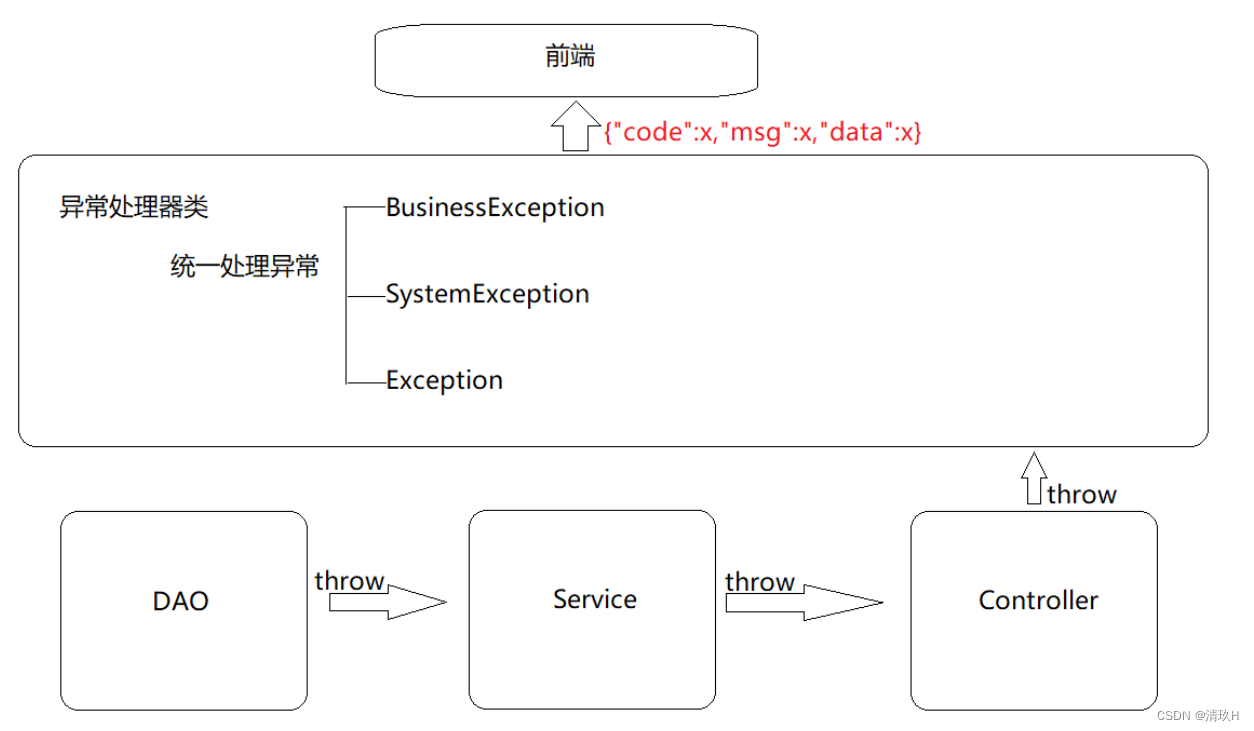- 1【VSCode】VScode 配置 Linux 驱动环境(简单版)_linux vscode
- 205_动态sql_动态sql与关联映射习题
- 3HarmonyOS构建第一个ArkTS应用(FA模型)_harmony os3.0.0的 sdk 选哪个
- 4YOLOv8改进 | 图像去雾 | 利用图像去雾网络UnfogNet辅助YOLOv8进行图像去雾检测(全网独家首发)
- 5关于Clang
- 6Uniapp浙政钉埋点_浙政钉 埋点 signkey 从哪里获取
- 7services.gradle.org的替代址
- 8固态存储是未来|浅析SSD架构的演进与创新技术-1
- 9鸿蒙开发路由跳转踩坑_鸿蒙页面无法跳转
- 10ISCE2StaMPS全流程
SSM整合(超详细)_ssm整合项目
赞
踩
流程分析
(1) 创建工程
- 创建一个Maven的web工程
- pom.xml添加SSM需要的依赖jar包
- 编写Web项目的入口配置类,实现
AbstractAnnotationConfigDispatcherServletInitializer重写以下方法- getRootConfigClasses() :返回Spring的配置类->需要SpringConfig配置类
- getServletConfigClasses() :返回SpringMVC的配置类->需要SpringMvcConfig配置类
- getServletMappings() : 设置SpringMVC请求拦截路径规则
- getServletFilters() :设置过滤器,解决POST请求中文乱码问题
(2)SSM整合[重点是各个配置的编写]
- SpringConfig
- 标识该类为配置类 @Configuration
- 扫描Service所在的包 @ComponentScan
- 在Service层要管理事务 @EnableTransactionManagement
- 读取外部的properties配置文件 @PropertySource
- 整合Mybatis需要引入Mybatis相关配置类 @Import
- 第三方数据源配置类 JdbcConfig
- 构建DataSource数据源,DruidDataSouroce,需要注入数据库连接四要素, @Bean @Value
- 构建平台事务管理器,DataSourceTransactionManager,@Bean
- Mybatis配置类 MybatisConfig
- 构建SqlSessionFactoryBean并设置别名扫描与数据源,@Bean
- 构建MapperScannerConfigurer并设置DAO层的包扫描
- 第三方数据源配置类 JdbcConfig
- SpringMvcConfig
- 标识该类为配置类 @Configuration
- 扫描Controller所在的包 @ComponentScan
- 开启SpringMVC注解支持 @EnableWebMvc
(3)功能模块[与具体的业务模块有关]
- 创建数据库表
- 根据数据库表创建对应的模型类
- 通过Dao层完成数据库表的增删改查(接口+自动代理)
- 编写Service层[Service接口+实现类]
- @Service
- @Transactional
- 整合Junit对业务层进行单元测试
- @RunWith
- @ContextConfiguration
- @Test
- 编写Controller层
- 接收请求 @RequestMapping @GetMapping @PostMapping @PutMapping @DeleteMapping
- 接收数据 简单、POJO、嵌套POJO、集合、数组、JSON数据类型
- @RequestParam
- @PathVariable
- @RequestBody
- 转发业务层
- @Autowired
- 响应结果
- @ResponseBody
整合配置
步骤一:创建Maven的web项目

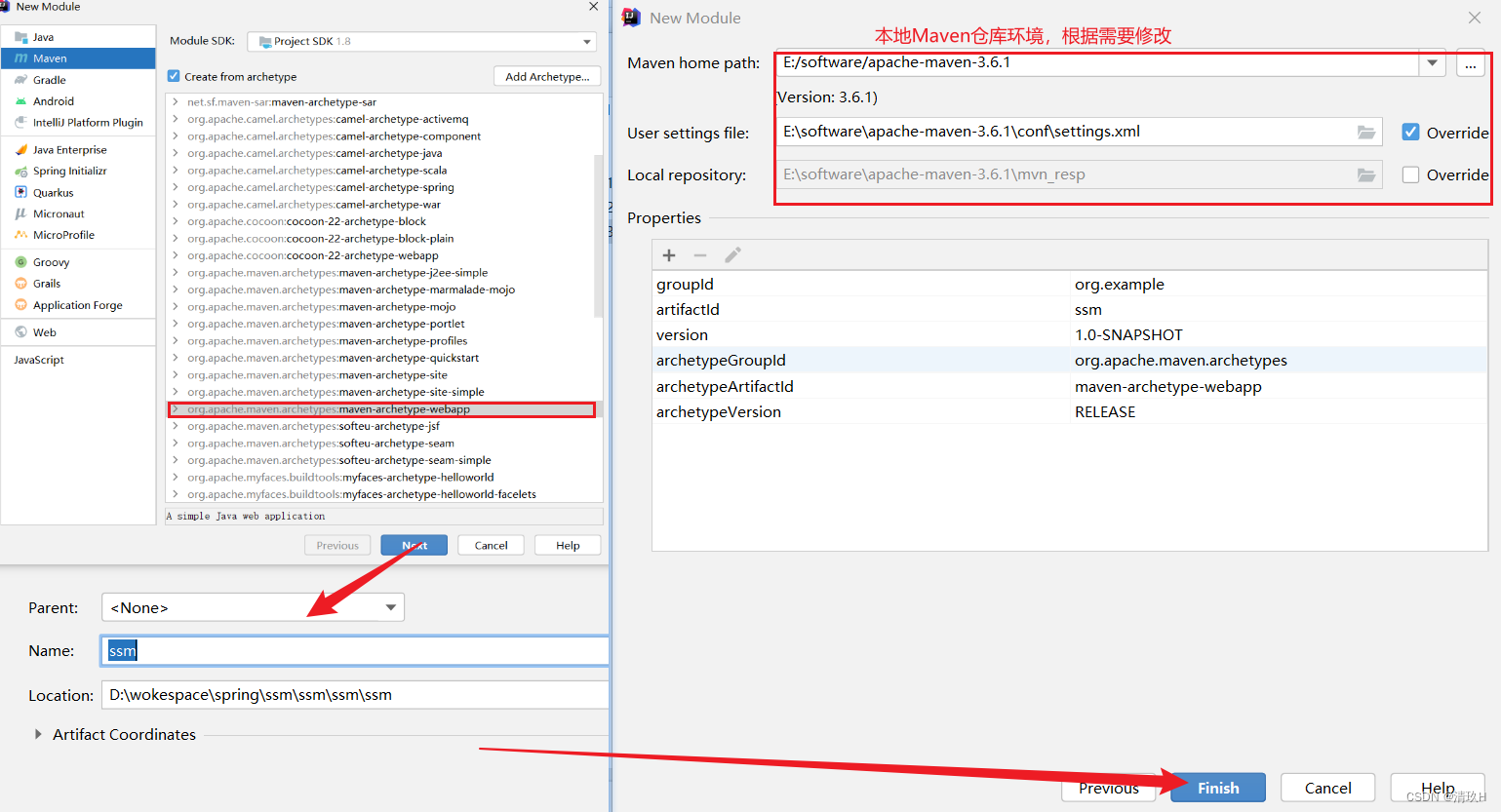
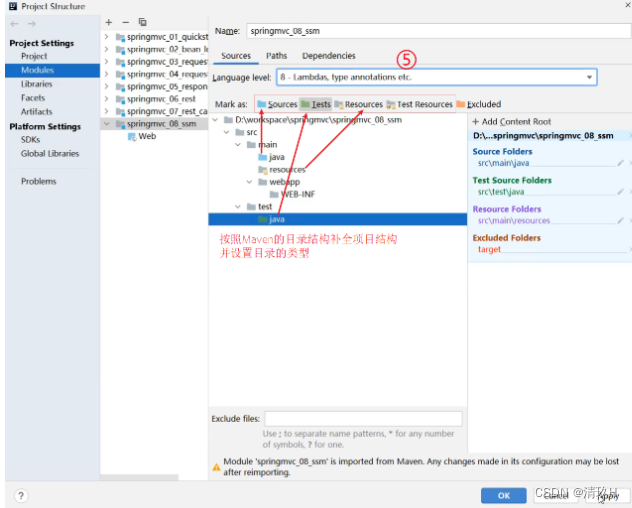
步骤二:添加依赖
pom.xml添加SSM所需要的依赖jar包
<?xml version="1.0" encoding="UTF-8"?> <project xmlns="http://maven.apache.org/POM/4.0.0" xmlns:xsi="http://www.w3.org/2001/XMLSchema-instance" xsi:schemaLocation="http://maven.apache.org/POM/4.0.0 http://maven.apache.org/xsd/maven-4.0.0.xsd"> <modelVersion>4.0.0</modelVersion> <groupId>com.mzh</groupId> <artifactId>ssm</artifactId> <version>1.0-SNAPSHOT</version> <packaging>war</packaging> <dependencies> <dependency> <groupId>org.springframework</groupId> <artifactId>spring-webmvc</artifactId> <version>5.2.10.RELEASE</version> </dependency> <dependency> <groupId>org.springframework</groupId> <artifactId>spring-jdbc</artifactId> <version>5.2.10.RELEASE</version> </dependency> <dependency> <groupId>org.springframework</groupId> <artifactId>spring-test</artifactId> <version>5.2.10.RELEASE</version> </dependency> <dependency> <groupId>org.mybatis</groupId> <artifactId>mybatis</artifactId> <version>3.5.6</version> </dependency> <dependency> <groupId>org.mybatis</groupId> <artifactId>mybatis-spring</artifactId> <version>1.3.0</version> </dependency> <dependency> <groupId>mysql</groupId> <artifactId>mysql-connector-java</artifactId> <version>5.1.47</version> </dependency> <dependency> <groupId>com.alibaba</groupId> <artifactId>druid</artifactId> <version>1.1.16</version> </dependency> <dependency> <groupId>junit</groupId> <artifactId>junit</artifactId> <version>4.12</version> <scope>test</scope> </dependency> <dependency> <groupId>javax.servlet</groupId> <artifactId>javax.servlet-api</artifactId> <version>3.1.0</version> <scope>provided</scope> </dependency> <dependency> <groupId>com.fasterxml.jackson.core</groupId> <artifactId>jackson-databind</artifactId> <version>2.9.0</version> </dependency> </dependencies> <build> <plugins> <plugin> <groupId>org.apache.tomcat.maven</groupId> <artifactId>tomcat7-maven-plugin</artifactId> <version>2.1</version> <configuration> <port>80</port> <path>/</path> </configuration> </plugin> </plugins> </build> </project>
- 1
- 2
- 3
- 4
- 5
- 6
- 7
- 8
- 9
- 10
- 11
- 12
- 13
- 14
- 15
- 16
- 17
- 18
- 19
- 20
- 21
- 22
- 23
- 24
- 25
- 26
- 27
- 28
- 29
- 30
- 31
- 32
- 33
- 34
- 35
- 36
- 37
- 38
- 39
- 40
- 41
- 42
- 43
- 44
- 45
- 46
- 47
- 48
- 49
- 50
- 51
- 52
- 53
- 54
- 55
- 56
- 57
- 58
- 59
- 60
- 61
- 62
- 63
- 64
- 65
- 66
- 67
- 68
- 69
- 70
- 71
- 72
- 73
- 74
- 75
- 76
- 77
- 78
- 79
- 80
- 81
- 82
- 83
- 84
- 85
- 86
- 87
- 88
- 89
步骤三:创建项目包结构
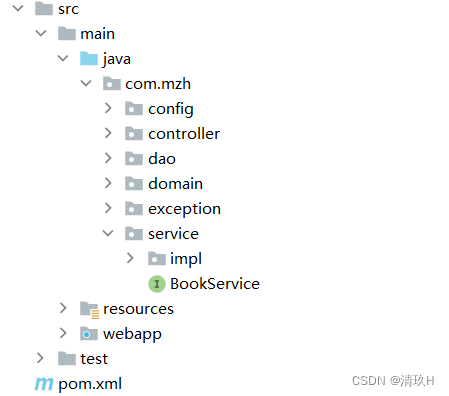
- config目录存放的是相关的配置类
- controller编写的是Controller类
- dao存放的是Dao接口,因为使用的是Mapper接口代理方式,所以没有实现类包
- service存的是Service接口,impl存放的是Service实现类
- resources:存入的是配置文件,如Jdbc.properties
- webapp:目录可以存放静态资源
- test/java:存放的是测试类
步骤四:创建SpringConfig配置类
@Configuration
@ComponentScan({"com.mzh.service"})
@PropertySource("classpath:jdbc.properties")
@Import({JdbcConfig.class,MyBatisConfig.class})
@EnableTransactionManagement
public class SpringConfig {
}
- 1
- 2
- 3
- 4
- 5
- 6
- 7
步骤五:创建JdbcConfig配置类
public class JdbcConfig { @Value("${jdbc.driver}") private String driver; @Value("${jdbc.url}") private String url; @Value("${jdbc.username}") private String username; @Value("${jdbc.password}") private String password; @Bean public DataSource dataSource(){ DruidDataSource dataSource = new DruidDataSource(); dataSource.setDriverClassName(driver); dataSource.setUrl(url); dataSource.setUsername(username); dataSource.setPassword(password); return dataSource; } @Bean public PlatformTransactionManager transactionManager(DataSource dataSource){ DataSourceTransactionManager ds = new DataSourceTransactionManager(); ds.setDataSource(dataSource); return ds; } }
- 1
- 2
- 3
- 4
- 5
- 6
- 7
- 8
- 9
- 10
- 11
- 12
- 13
- 14
- 15
- 16
- 17
- 18
- 19
- 20
- 21
- 22
- 23
- 24
- 25
- 26
- 27
步骤六:创建MybatisConfig配置类
public class MyBatisConfig { @Bean public SqlSessionFactoryBean sqlSessionFactory(DataSource dataSource){ SqlSessionFactoryBean factoryBean = new SqlSessionFactoryBean(); factoryBean.setDataSource(dataSource); factoryBean.setTypeAliasesPackage("com.mzh.domain"); return factoryBean; } @Bean public MapperScannerConfigurer mapperScannerConfigurer(){ MapperScannerConfigurer msc = new MapperScannerConfigurer(); msc.setBasePackage("com.mzh.dao"); return msc; } }
- 1
- 2
- 3
- 4
- 5
- 6
- 7
- 8
- 9
- 10
- 11
- 12
- 13
- 14
- 15
- 16
步骤七:创建jdbc.properties
jdbc.driver=com.mysql.jdbc.Driver
jdbc.url=jdbc:mysql://localhost:3306/ssm_db?useSSL=false
jdbc.username=root
jdbc.password=123456
- 1
- 2
- 3
- 4
步骤八:创建SpringMVC配置类
@Configuration
@ComponentScan("com.mzh.controller")
@EnableWebMvc
public class SpringMvcConfig {
}
- 1
- 2
- 3
- 4
- 5
步骤九:创建Web项目入口配置类
public class ServletConfig extends AbstractAnnotationConfigDispatcherServletInitializer { //加载Spring配置类 protected Class<?>[] getRootConfigClasses() { return new Class[]{SpringConfig.class}; } //加载SpringMVC配置类 protected Class<?>[] getServletConfigClasses() { return new Class[]{SpringMvcConfig.class}; } //设置SpringMVC请求地址拦截规则 protected String[] getServletMappings() { return new String[]{"/"}; } //设置post请求中文乱码过滤器 @Override protected Filter[] getServletFilters() { CharacterEncodingFilter filter = new CharacterEncodingFilter(); filter.setEncoding("utf-8"); return new Filter[]{filter}; } }
- 1
- 2
- 3
- 4
- 5
- 6
- 7
- 8
- 9
- 10
- 11
- 12
- 13
- 14
- 15
- 16
- 17
- 18
- 19
- 20
- 21
至此SSM整合的环境就已经搭建好了。在这个环境上,我们如何进行功能模块的开发呢?
功能模块开发
需求:对表tbl_book进行新增、修改、删除、根据ID查询和查询所有
步骤一:创建数据库及表
create database ssm_db character set utf8; use ssm_db; create table tbl_book( id int primary key auto_increment, type varchar(20), name varchar(50), description varchar(255) ) insert into `tbl_book`(`id`,`type`,`name`,`description`) values (1,'计算机理论','Spring实战 第五版','Spring入门经典教程,深入理解Spring原理技术内幕'), (2,'计算机理论','Spring 5核心原理与30个类手写实践','十年沉淀之作,手写Spring精华思想'), (3,'计算机理论','Spring 5设计模式','深入Spring源码刨析Spring源码中蕴含的10大设计模式'), (4,'计算机理论','Spring MVC+Mybatis开发从入门到项目实战','全方位解析面向Web应用的轻量级框架,带你成为Spring MVC开发高手'), (5,'计算机理论','轻量级Java Web企业应用实战','源码级刨析Spring框架,适合已掌握Java基础的读者'),(6,'计算机理论','Java核心技术 卷Ⅰ 基础知识(原书第11版)','Core Java第11版,Jolt大奖获奖作品,针对Java SE9、10、11全面更新'), (7,'计算机理论','深入理解Java虚拟机','5个纬度全面刨析JVM,大厂面试知识点全覆盖'), (8,'计算机理论','Java编程思想(第4版)','Java学习必读经典,殿堂级著作!赢得了全球程序员的广泛赞誉'),(9,'计算机理论','零基础学Java(全彩版)','零基础自学编程的入门图书,由浅入深,详解Java语言的编程思想和核心技术'), (10,'市场营销','直播就这么做:主播高效沟通实战指南','李子柒、李佳奇、薇娅成长为网红的秘密都在书中'), (11,'市场营销','直播销讲实战一本通','和秋叶一起学系列网络营销书籍'),(12,'市场营销','直播带货:淘宝、天猫直播从新手到高手','一本教你如何玩转直播的书,10堂课轻松实现带货月入3W+');
- 1
- 2
- 3
- 4
- 5
- 6
- 7
- 8
- 9
- 10
- 11
- 12
- 13
- 14
- 15
- 16
- 17
- 18
- 19
步骤二:编写模型类
public class Book {
private Integer id;
private String type;
private String name;
private String description;
//getter...setter...toString省略
}
- 1
- 2
- 3
- 4
- 5
- 6
- 7
步骤三:编写Dao接口
public interface BookDao { @Insert("insert into tbl_book (type,name,description) values(#{type},#{name},#{description})") public void save(Book book); @Update("update tbl_book set type = #{type}, name = #{name}, description = #{description} where id = #{id}") public void update(Book book); @Delete("delete from tbl_book where id = #{id}") public void delete(Integer id); @Select("select * from tbl_book where id = #{id}") public Book getById(Integer id); @Select("select * from tbl_book") public List<Book> getAll(); }
- 1
- 2
- 3
- 4
- 5
- 6
- 7
- 8
- 9
- 10
- 11
- 12
- 13
- 14
- 15
- 16
- 17
步骤四:编写Service接口和实现类
@Transactional public interface BookService { /** * 保存 * @param book * @return */ public boolean save(Book book); /** * 修改 * @param book * @return */ public boolean update(Book book); /** * 按id删除 * @param id * @return */ public boolean delete(Integer id); /** * 按id查询 * @param id * @return */ public Book getById(Integer id); /** * 查询全部 * @return */ public List<Book> getAll(); }
- 1
- 2
- 3
- 4
- 5
- 6
- 7
- 8
- 9
- 10
- 11
- 12
- 13
- 14
- 15
- 16
- 17
- 18
- 19
- 20
- 21
- 22
- 23
- 24
- 25
- 26
- 27
- 28
- 29
- 30
- 31
- 32
- 33
- 34
- 35
- 36
@Service public class BookServiceImpl implements BookService { @Autowired private BookDao bookDao; public boolean save(Book book) { bookDao.save(book); return true; } public boolean update(Book book) { bookDao.update(book); return true; } public boolean delete(Integer id) { bookDao.delete(id); return true; } public Book getById(Integer id) { return bookDao.getById(id); } public List<Book> getAll() { return bookDao.getAll(); } }
- 1
- 2
- 3
- 4
- 5
- 6
- 7
- 8
- 9
- 10
- 11
- 12
- 13
- 14
- 15
- 16
- 17
- 18
- 19
- 20
- 21
- 22
- 23
- 24
- 25
- 26
- 27
- 28
说明:
-
bookDao在Service中注入的会提示一个红线提示,为什么呢?
- BookDao是一个接口,没有实现类,接口是不能创建对象的,所以最终注入的应该是代理对象
- 代理对象是由Spring的IOC容器来创建管理的
- IOC容器又是在Web服务器启动的时候才会创建
- IDEA在检测依赖关系的时候,没有找到适合的类注入,所以会提示错误提示
- 但是程序运行的时候,代理对象就会被创建,框架会使用DI进行注入,所以程序运行无影响。
-
如何解决上述问题?
-
可以不用理会,因为运行是正常的
-
设置错误提示级别
-
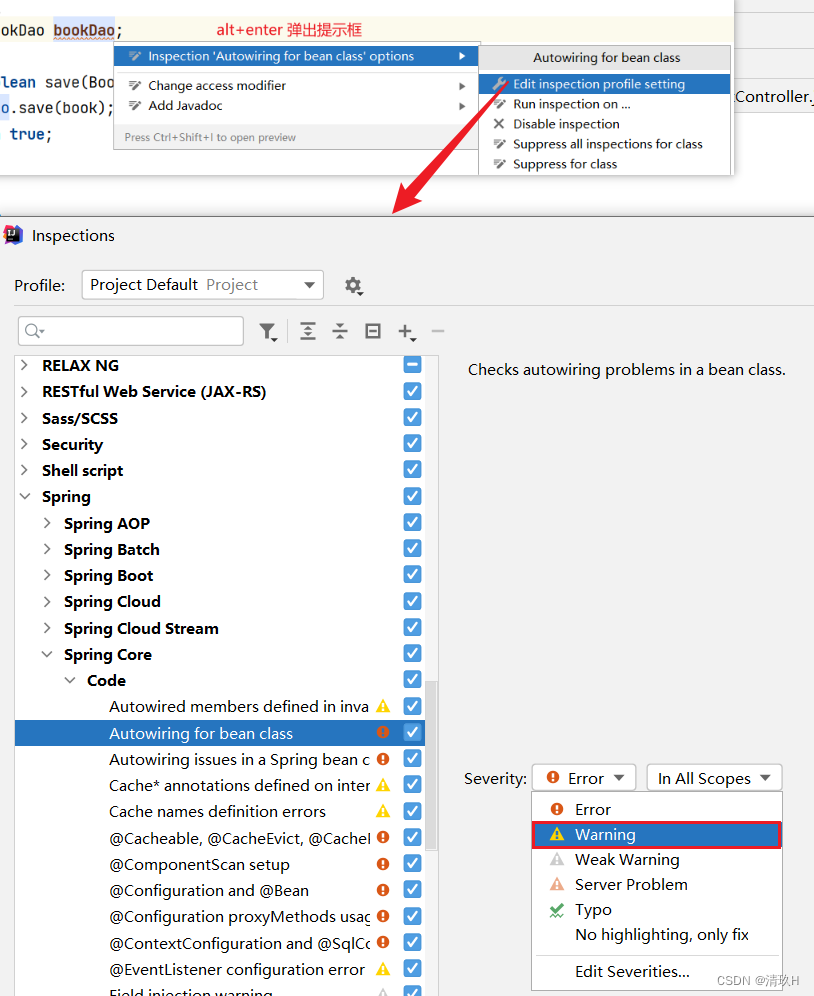
步骤五:编写Contorller类
@RestController @RequestMapping("/books") public class BookController { @Autowired private BookService bookService; @PostMapping public boolean save(@RequestBody Book book) { return bookService.save(book); } @PutMapping public boolean update(@RequestBody Book book) { return bookService.update(book); } @DeleteMapping("/{id}") public boolean delete(@PathVariable Integer id) { return bookService.delete(id); } @GetMapping("/{id}") public Book getById(@PathVariable Integer id) { return bookService.getById(id); } @GetMapping public List<Book> getAll() { return bookService.getAll(); } }
- 1
- 2
- 3
- 4
- 5
- 6
- 7
- 8
- 9
- 10
- 11
- 12
- 13
- 14
- 15
- 16
- 17
- 18
- 19
- 20
- 21
- 22
- 23
- 24
- 25
- 26
- 27
- 28
- 29
- 30
- 31
- 32
对于图书模块的增删改查就已经完成了编写,我们可以从后往前写也可以从前往后写,最终只需要能把功能实现即可。
接下来我们就先把业务层的代码使用Spring整合Junit的知识点进行单元测试
单元测试
步骤一:新建测试类
@RunWith(SpringJUnit4ClassRunner.class)
@ContextConfiguration(classes = SpringConfig.class)
public class BookServiceTest {
}
- 1
- 2
- 3
- 4
- 5
步骤二:注入Service类
@RunWith(SpringJUnit4ClassRunner.class)
@ContextConfiguration(classes = SpringConfig.class)
public class BookServiceTest {
@Autowired
private BookService bookService;
}
- 1
- 2
- 3
- 4
- 5
- 6
- 7
- 8
- 9
步骤三:编写测试方法
我们先来对查询进行单元测试
@RunWith(SpringJUnit4ClassRunner.class) @ContextConfiguration(classes = SpringConfig.class) public class BookServiceTest { @Autowired private BookService bookService; @Test public void testGetById(){ Book book = bookService.getById(1); System.out.println(book); } @Test public void testGetAll(){ List<Book> all = bookService.getAll(); System.out.println(all); } }
- 1
- 2
- 3
- 4
- 5
- 6
- 7
- 8
- 9
- 10
- 11
- 12
- 13
- 14
- 15
- 16
- 17
- 18
- 19
- 20
根据ID查询,测试的结果为:

查询所有,测试的结果为:

PostMan测试
新增
http://localhost/books
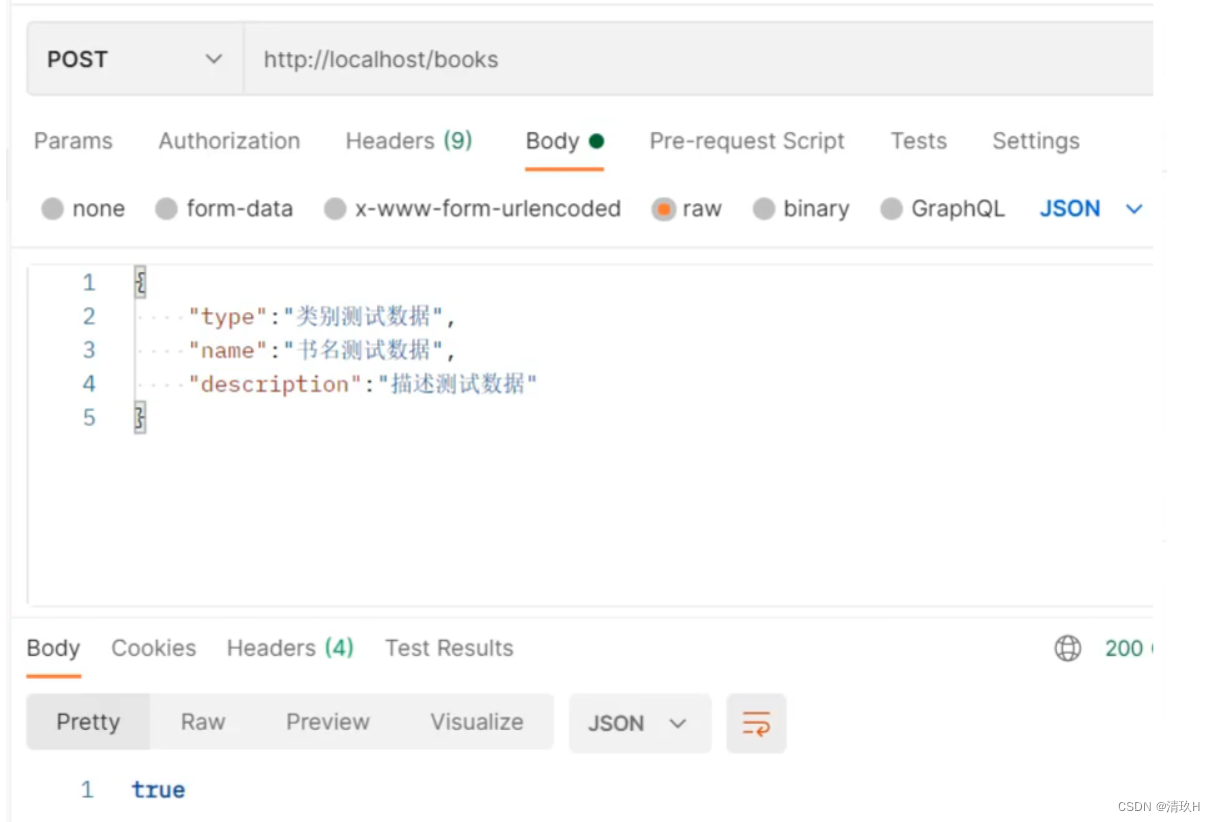
修改
http://localhost/books
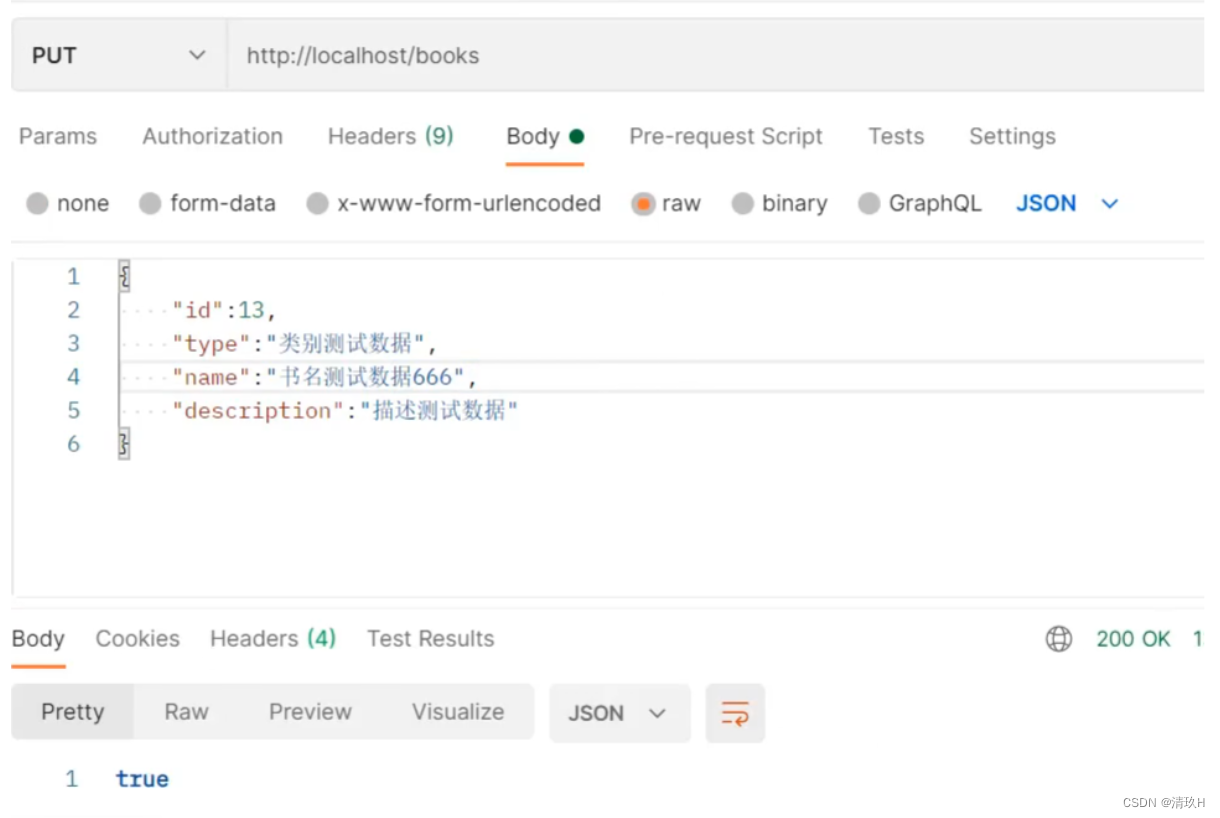
删除
http://localhost/books/14
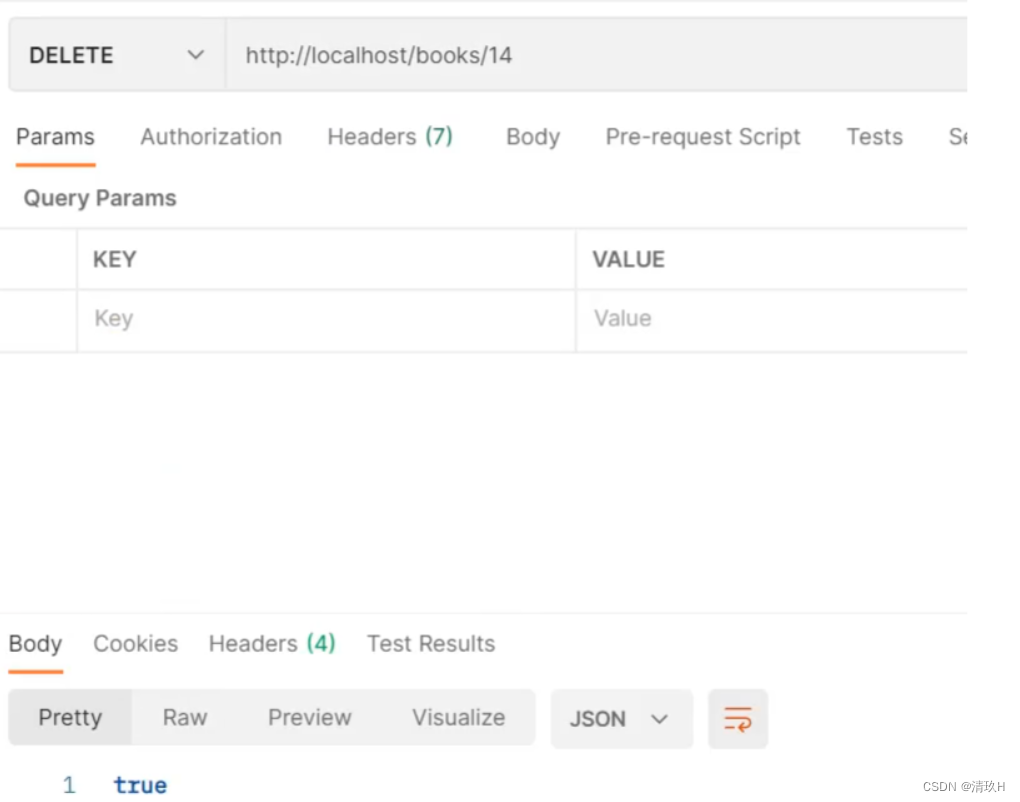
查询单个
http://localhost/books/1
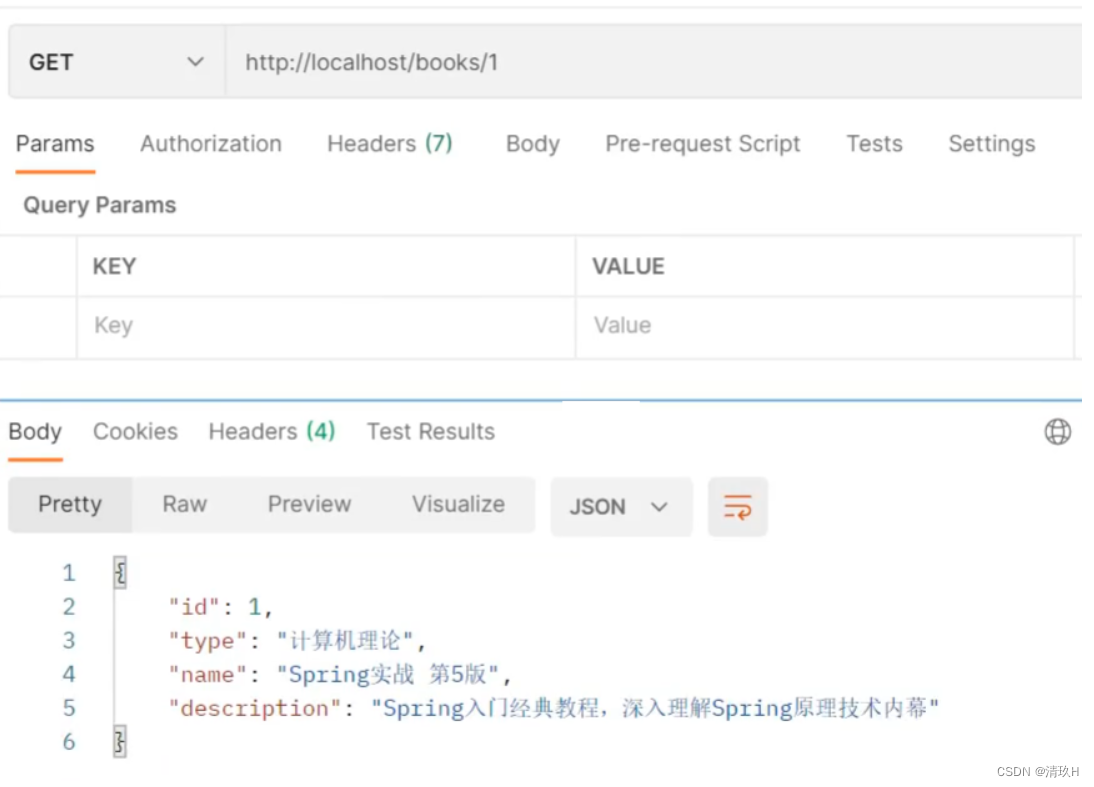
查询所有
http://localhost/books
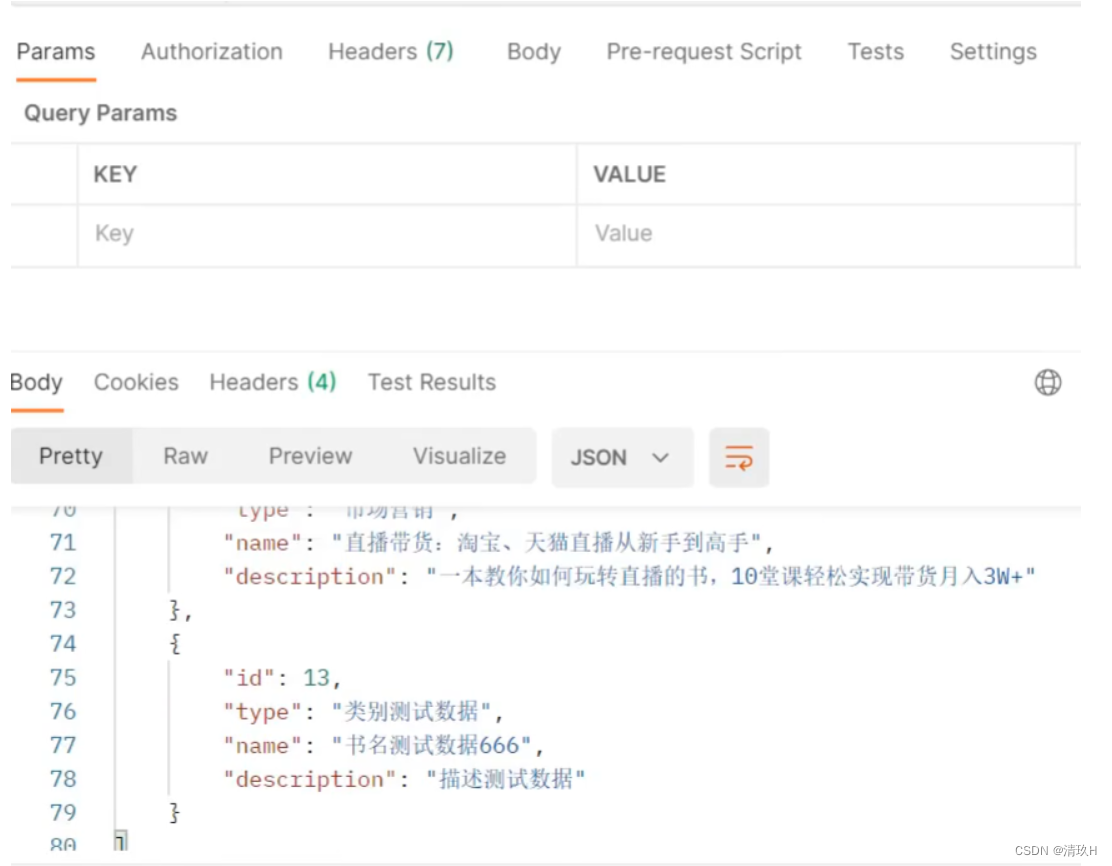
统一结果封装
表现层与前端数据传输协议定义
SSM整合以及功能模块开发完成后,接下来,我们在上述案例的基础上分析下有哪些问题需要我们去解决下。首先第一个问题是:
-
在Controller层增删改返回给前端的是boolean类型数据

-
在Controller层查询单个返回给前端的是对象
![[外链图片转存失败,源站可能有防盗链机制,建议将图片保存下来直接上传(img-oWid5Ihi-1674285092621)(assets/1630653385377.png)]](https://img-blog.csdnimg.cn/e0a79fa4f8b140759055fce650d2570e.png)
-
在Controller层查询所有返回给前端的是集合对象
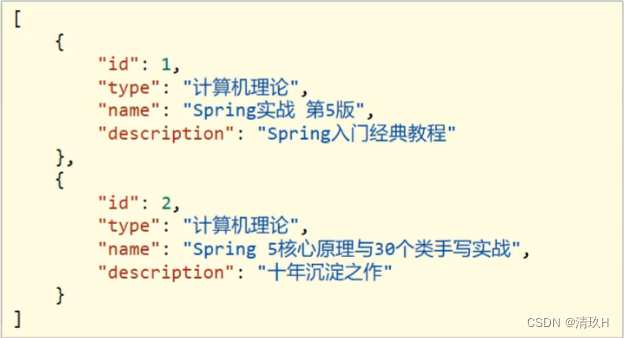
目前我们就已经有三种数据类型返回给前端,如果随着业务的增长,我们需要返回的数据类型会越来越多。对于前端开发人员在解析数据的时候就比较凌乱了,所以对于前端来说,如果后台能够返回一个统一的数据结果,前端在解析的时候就可以按照一种方式进行解析。开发就会变得更加简单。
所以我们就想能不能将返回结果的数据进行统一,具体如何来做,大体的思路为:
- 为了封装返回的结果数据:创建结果模型类,封装数据到data属性中
- 为了封装返回的数据是何种操作及是否操作成功:封装操作结果到code属性中
- 操作失败后为了封装返回的错误信息:封装特殊消息到message(msg)属性中
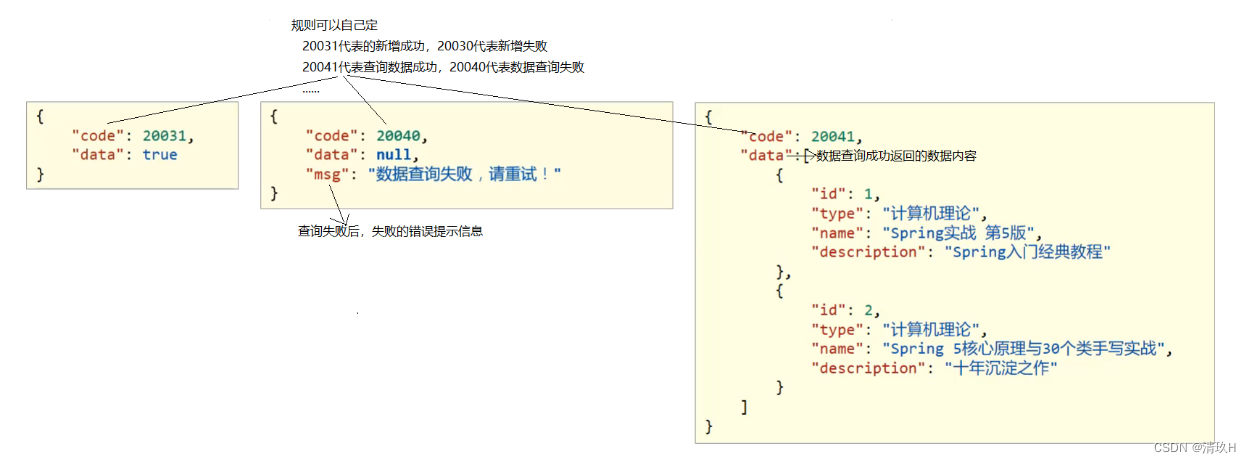
根据分析,我们可以设置统一数据返回结果类
public class Result{
private Object data;
private Integer code;
private String msg;
}
- 1
- 2
- 3
- 4
- 5
注意: Result类名及类中的字段并不是固定的,可以根据需要自行增减提供若干个构造方法,方便操作
表现层与前端数据传输协议实现
步骤一:创建Result类
public class Result { //描述统一格式中的数据 private Object data; //描述统一格式中的编码,用于区分操作,可以简化配置0或1表示成功失败 private Integer code; //描述统一格式中的消息,可选属性 private String msg; public Result() { } //构造方法是方便对象的创建 public Result(Integer code,Object data) { this.data = data; this.code = code; } //构造方法是方便对象的创建 public Result(Integer code, Object data, String msg) { this.data = data; this.code = code; this.msg = msg; } //setter...getter...省略 }
- 1
- 2
- 3
- 4
- 5
- 6
- 7
- 8
- 9
- 10
- 11
- 12
- 13
- 14
- 15
- 16
- 17
- 18
- 19
- 20
- 21
- 22
- 23
步骤二:定义返回码Code类
//状态码
public class Code {
public static final Integer SAVE_OK = 20011;
public static final Integer DELETE_OK = 20021;
public static final Integer UPDATE_OK = 20031;
public static final Integer GET_OK = 20041;
public static final Integer SAVE_ERR = 20010;
public static final Integer DELETE_ERR = 20020;
public static final Integer UPDATE_ERR = 20030;
public static final Integer GET_ERR = 20040;
}
- 1
- 2
- 3
- 4
- 5
- 6
- 7
- 8
- 9
- 10
- 11
- 12
注意: code类中的常量设计也不是固定的,可以根据需要自行增减,例如将查询再进行细分为GET_OK,GET_ALL_OK,GET_PAGE_OK等
步骤三:修改Controller类的返回值
//统一每一个控制器方法返回值 @RestController @RequestMapping("/books") public class BookController { @Autowired private BookService bookService; @PostMapping public Result save(@RequestBody Book book) { boolean flag = bookService.save(book); return new Result(flag ? Code.SAVE_OK:Code.SAVE_ERR,flag); } @PutMapping public Result update(@RequestBody Book book) { boolean flag = bookService.update(book); return new Result(flag ? Code.UPDATE_OK:Code.UPDATE_ERR,flag); } @DeleteMapping("/{id}") public Result delete(@PathVariable Integer id) { boolean flag = bookService.delete(id); return new Result(flag ? Code.DELETE_OK:Code.DELETE_ERR,flag); } @GetMapping("/{id}") public Result getById(@PathVariable Integer id) { Book book = bookService.getById(id); Integer code = book != null ? Code.GET_OK : Code.GET_ERR; String msg = book != null ? "" : "数据查询失败,请重试!"; return new Result(code,book,msg); } @GetMapping public Result getAll() { List<Book> bookList = bookService.getAll(); Integer code = bookList != null ? Code.GET_OK : Code.GET_ERR; String msg = bookList != null ? "" : "数据查询失败,请重试!"; return new Result(code,bookList,msg); } }
- 1
- 2
- 3
- 4
- 5
- 6
- 7
- 8
- 9
- 10
- 11
- 12
- 13
- 14
- 15
- 16
- 17
- 18
- 19
- 20
- 21
- 22
- 23
- 24
- 25
- 26
- 27
- 28
- 29
- 30
- 31
- 32
- 33
- 34
- 35
- 36
- 37
- 38
- 39
- 40
- 41
- 42
步骤四:启动服务测试

至此,我们的返回结果就已经能以一种统一的格式返回给前端。前端根据返回的结果,先从中获取code,根据code判断,如果成功则取data属性的值,如果失败,则取msg中的值做提示
统一异常处理
问题描述
在讲解这一部分知识点之前,我们先来演示个效果,修改BookController类的getById方法
@GetMapping("/{id}")
public Result getById(@PathVariable Integer id) {
//手动添加一个错误信息
if(id==1){
int i = 1/0;
}
Book book = bookService.getById(id);
Integer code = book != null ? Code.GET_OK : Code.GET_ERR;
String msg = book != null ? "" : "数据查询失败,请重试!";
return new Result(code,book,msg);
}
- 1
- 2
- 3
- 4
- 5
- 6
- 7
- 8
- 9
- 10
- 11
重新启动运行项目,使用PostMan发送请求,当传入的id为1,则会出现如下效果:
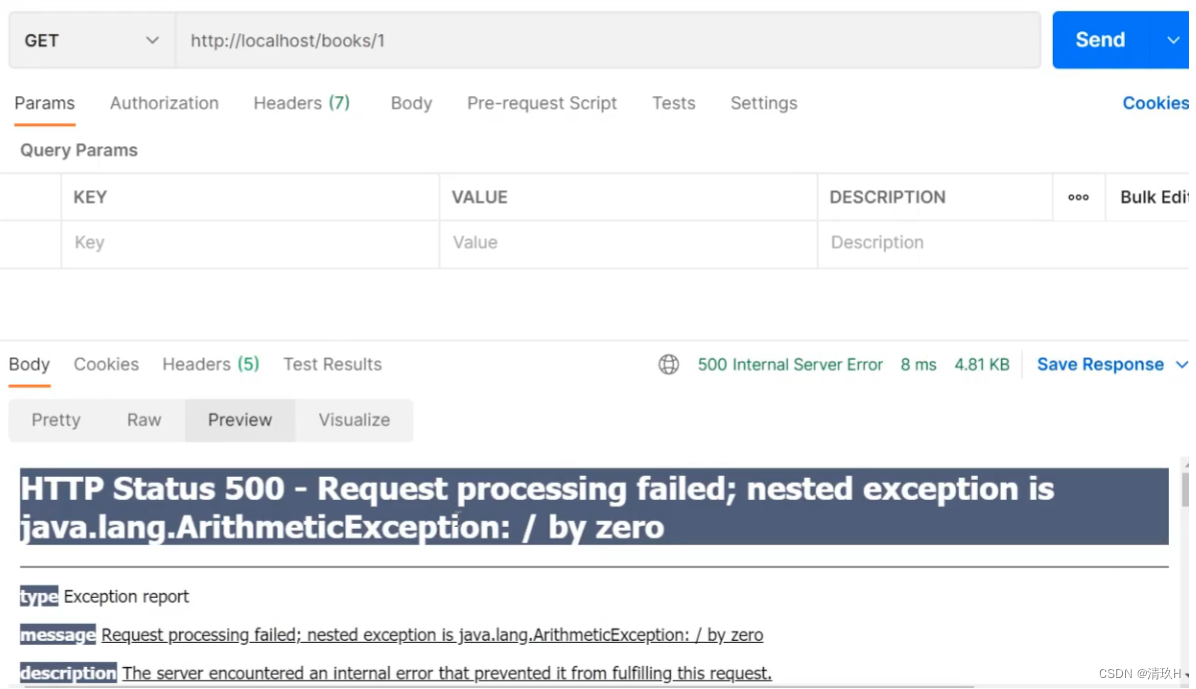
前端接收到这个信息后和之前我们约定的格式不一致,这个问题该如何解决?
在解决问题之前,我们先来看下异常的种类及出现异常的原因:
- 框架内部抛出的异常:因使用不合规导致
- 数据层抛出的异常:因外部服务器故障导致(例如:服务器访问超时)
- 业务层抛出的异常:因业务逻辑书写错误导致(例如:遍历业务书写操作,导致索引异常等)
- 表现层抛出的异常:因数据收集、校验等规则导致(例如:不匹配的数据类型间导致异常)
- 工具类抛出的异常:因工具类书写不严谨不够健壮导致(例如:必要释放的连接长期未释放等)
看完上面这些出现异常的位置,你会发现,在我们开发的任何一个位置都有可能出现异常,而且这些异常是不能避免的。所以我们就得将异常进行处理
思考
-
各个层级均出现异常,异常处理代码书写在哪一层?
所有的异常均抛出到表现层进行处理
-
异常的种类很多,表现层如何将所有的异常都处理到呢?
异常分类
-
表现层处理异常,每个方法中单独书写,代码书写量巨大且意义不强,如何解决?
AOP
对于上面这些问题及解决方案,SpringMVC已经为我们提供了一套解决方案:
-
异常处理器:
- 集中的、统一的处理项目中出现的异常
异常处理器的使用
使用步骤
步骤一:创建异常处理器类
//@RestControllerAdvice用于标识当前类为REST风格对应的异常处理器
@RestControllerAdvice
public class ProjectExceptionAdvice {
//除了自定义的异常处理器,保留对Exception类型的异常处理,用于处理非预期的异常
@ExceptionHandler(Exception.class)
public void doException(Exception ex){
System.out.println("嘿嘿,异常你哪里跑!")
}
}
- 1
- 2
- 3
- 4
- 5
- 6
- 7
- 8
- 9
确保SpringMvcConfig能够扫描到异常处理器类
步骤二:让程序抛出异常
修改BookController的getById方法,添加int i = 1/0.
@GetMapping("/{id}")
public Result getById(@PathVariable Integer id) {
int i = 1/0;
Book book = bookService.getById(id);
Integer code = book != null ? Code.GET_OK : Code.GET_ERR;
String msg = book != null ? "" : "数据查询失败,请重试!";
return new Result(code,book,msg);
}
- 1
- 2
- 3
- 4
- 5
- 6
- 7
- 8
步骤三:运行程序,测试

说明异常已经被拦截并执行了doException方法
步骤四:异常处理器类返回结果给前端
//@RestControllerAdvice用于标识当前类为REST风格对应的异常处理器
@RestControllerAdvice
public class ProjectExceptionAdvice {
//除了自定义的异常处理器,保留对Exception类型的异常处理,用于处理非预期的异常
@ExceptionHandler(Exception.class)
public Result doException(Exception ex){
System.out.println("嘿嘿,异常你哪里跑!")
return new Result(666,null,"嘿嘿,异常你哪里跑!");
}
}
- 1
- 2
- 3
- 4
- 5
- 6
- 7
- 8
- 9
- 10
启动运行程序,测试:
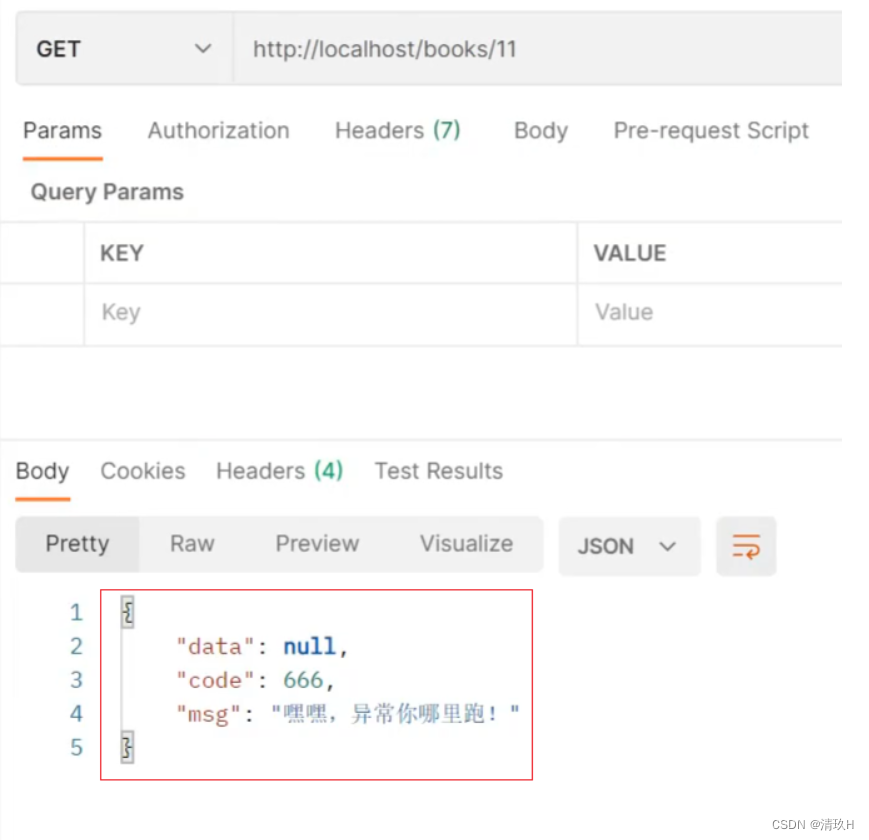
至此,就算后台执行的过程中抛出异常,最终也能按照我们和前端约定好的格式返回给前端
知识点1:@RestControllerAdvice
| 名称 | @RestControllerAdvice |
|---|---|
| 类型 | 类注解 |
| 位置 | Rest风格开发的控制器增强类定义上方 |
| 作用 | 为Rest风格开发的控制器类做增强 |
说明: 此注解自带@ResponseBody注解与@Component注解,具备对应的功能
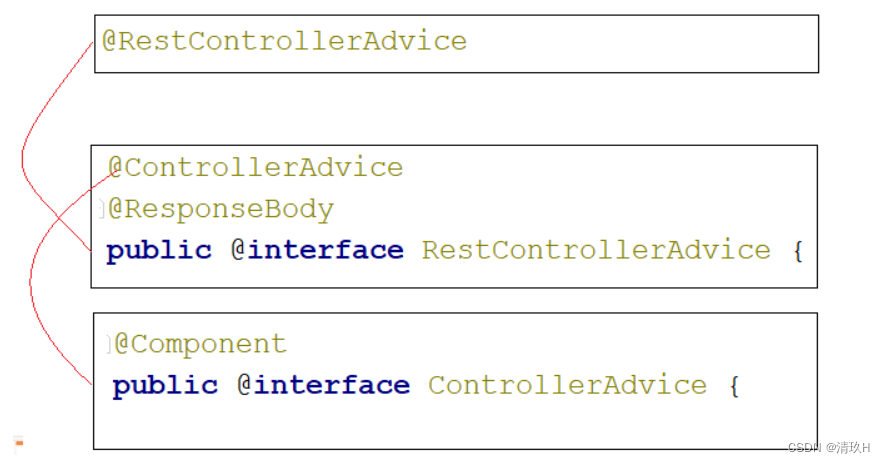
知识点2:@ExceptionHandler
| 名称 | @ExceptionHandler |
|---|---|
| 类型 | 方法注解 |
| 位置 | 专用于异常处理的控制器方法上方 |
| 作用 | 设置指定异常的处理方案,功能等同于控制器方法, 出现异常后终止原始控制器执行,并转入当前方法执行 |
说明: 此类方法可以根据处理的异常不同,制作多个方法分别处理对应的异常
项目异常处理方案
异常分类
异常处理器我们已经能够使用了,那么在项目中该如何来处理异常呢?
因为异常的种类有很多,如果每一个异常都对应一个@ExceptionHandler,那得写多少个方法来处理各自的异常,所以我们在处理异常之前,需要对异常进行一个分类:
-
业务异常(BusinessException)
-
规范的用户行为产生的异常
-
用户在页面输入内容的时候未按照指定格式进行数据填写,如在年龄框输入的是字符串
![[外链图片转存失败,源站可能有防盗链机制,建议将图片保存下来直接上传(img-ejjUwY53-1674287468244)(assets/1630659599983.png)]](https://img-blog.csdnimg.cn/ae3f2efc30d54062b048619f90fd0f87.png)
-
-
不规范的用户行为操作产生的异常
-
如用户故意传递错误数据
![[外链图片转存失败,源站可能有防盗链机制,建议将图片保存下来直接上传(img-nvEF8Xc8-1674287468245)(assets/1630659622958.png)]](https://img-blog.csdnimg.cn/f387875cb97443b1a901710ff86e8966.png)
-
-
-
系统异常(SystemException)
- 项目运行过程中可预计但无法避免的异常
- 比如数据库或服务器宕机
- 项目运行过程中可预计但无法避免的异常
-
其他异常(Exception)
-
编程人员未预期到的异常,如:用到的文件不存在
![[外链图片转存失败,源站可能有防盗链机制,建议将图片保存下来直接上传(img-fq7jyTJS-1674287468246)(assets/1630659690341.png)]](https://img-blog.csdnimg.cn/2bd792135bf643bd998bca51b2959f25.png)
将异常分类以后,针对不同类型的异常,要提供具体的解决方案:
-
异常解决方案
- 业务异常(BusinessException)
- 发送对应消息传递给用户,提醒规范操作
- 大家常见的就是提示用户名已存在或密码格式不正确等
- 发送对应消息传递给用户,提醒规范操作
- 系统异常(SystemException)
-
发送固定消息传递给用户,安抚用户
- 系统繁忙,请稍后再试
- 系统正在维护升级,请稍后再试
- 系统出问题,请联系系统管理员等
-
发送特定消息给运维人员,提醒维护
-
记录日志
- 发消息和记录日志对用户来说是不可见的,属于后台程序
-
- 其他异常(Exception)
- 发送固定消息传递给用户,安抚用户
- 发送特定消息给编程人员,提醒维护(纳入预期范围内)
- 一般是程序没有考虑全,比如未做非空校验等
- 记录日志
异常解决方案的具体实现
步骤一:自定义异常类
//自定义异常处理器,用于封装异常信息,对异常进行分类
public class SystemException extends RuntimeException{ private Integer code; public Integer getCode() { return code; } public void setCode(Integer code) { this.code = code; } public SystemException(Integer code, String message) { super(message); this.code = code; } public SystemException(Integer code, String message, Throwable cause) { super(message, cause); this.code = code; } } //自定义异常处理器,用于封装异常信息,对异常进行分类 public class BusinessException extends RuntimeException{ private Integer code; public Integer getCode() { return code; } public void setCode(Integer code) { this.code = code; } public BusinessException(Integer code, String message) { super(message); this.code = code; } public BusinessException(Integer code, String message, Throwable cause) { super(message, cause); this.code = code; } }
- 1
- 2
- 3
- 4
- 5
- 6
- 7
- 8
- 9
- 10
- 11
- 12
- 13
- 14
- 15
- 16
- 17
- 18
- 19
- 20
- 21
- 22
- 23
- 24
- 25
- 26
- 27
- 28
- 29
- 30
- 31
- 32
- 33
- 34
- 35
- 36
- 37
- 38
- 39
- 40
- 41
- 42
- 43
- 44
- 45
- 46
说明:
- 让自定义异常类继承
RuntimeException的好处是,后期在抛出这两个异常的时候,就不用在try…catch…或throws了 - 自定义异常类中添加
code属性的原因是为了更好的区分异常是来自哪个业务的
步骤二:将其他异常包成自定义异常
public Book getById(Integer id) {
//模拟业务异常,包装成自定义异常
if(id == 1){
throw new BusinessException(Code.BUSINESS_ERR,"输入的数据有误");
}
//模拟系统异常,将可能出现的异常进行包装,转换成自定义异常
try{
int i = 1/0;
}catch (Exception e){
throw new SystemException(Code.SYSTEM_TIMEOUT_ERR,"服务器访问超时,请重试!",e);
}
return bookDao.getById(id);
}
- 1
- 2
- 3
- 4
- 5
- 6
- 7
- 8
- 9
- 10
- 11
- 12
- 13
具体的包装方式有:
- 方式一:
try{}catch(){}在catch中重新throw我们自定义异常即可。 - 方式二:直接throw自定义异常即可
上面为了使code看着更专业些,我们在Code类中再新增需要的属性
//状态码 public class Code { public static final Integer SAVE_OK = 20011; public static final Integer DELETE_OK = 20021; public static final Integer UPDATE_OK = 20031; public static final Integer GET_OK = 20041; public static final Integer SAVE_ERR = 20010; public static final Integer DELETE_ERR = 20020; public static final Integer UPDATE_ERR = 20030; public static final Integer GET_ERR = 20040; public static final Integer SYSTEM_ERR = 50001; public static final Integer SYSTEM_TIMEOUT_ERR = 50002; public static final Integer SYSTEM_UNKNOW_ERR = 59999; public static final Integer BUSINESS_ERR = 60002; }
- 1
- 2
- 3
- 4
- 5
- 6
- 7
- 8
- 9
- 10
- 11
- 12
- 13
- 14
- 15
- 16
- 17
步骤三:处理器类中处理自定义异常
//@RestControllerAdvice用于标识当前类为REST风格对应的异常处理器 @RestControllerAdvice public class ProjectExceptionAdvice { //@ExceptionHandler用于设置当前处理器类对应的异常类型 @ExceptionHandler(SystemException.class) public Result doSystemException(SystemException ex){ //记录日志 //发送消息给运维 //发送邮件给开发人员,ex对象发送给开发人员 return new Result(ex.getCode(),null,ex.getMessage()); } @ExceptionHandler(BusinessException.class) public Result doBusinessException(BusinessException ex){ return new Result(ex.getCode(),null,ex.getMessage()); } //除了自定义的异常处理器,保留对Exception类型的异常处理,用于处理非预期的异常 @ExceptionHandler(Exception.class) public Result doOtherException(Exception ex){ //记录日志 //发送消息给运维 //发送邮件给开发人员,ex对象发送给开发人员 return new Result(Code.SYSTEM_UNKNOW_ERR,null,"系统繁忙,请稍后再试!"); } }
- 1
- 2
- 3
- 4
- 5
- 6
- 7
- 8
- 9
- 10
- 11
- 12
- 13
- 14
- 15
- 16
- 17
- 18
- 19
- 20
- 21
- 22
- 23
- 24
- 25
- 26
对于异常我们就已经处理完成了,不管后台哪一层抛出异常,都会以我们与前端约定好的方式进行返回,前端只需要把信息获取到,根据返回的正确与否来展示不同的内容即可
小结
以后项目中的异常处理方式为:
